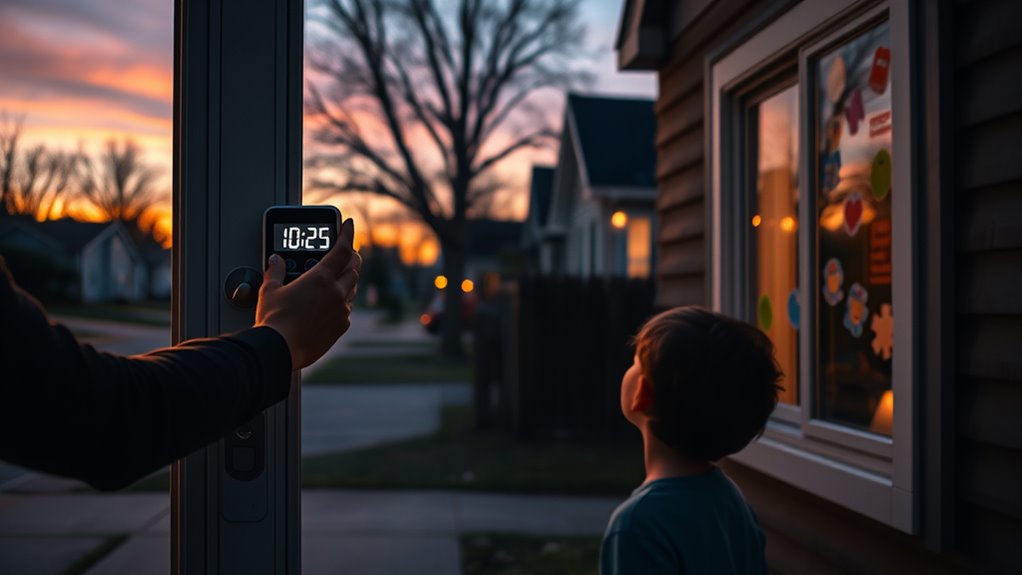To strike the right balance between trust and safety, set clear, consistent curfews and rules that protect your teen without stifling their independence. Involve them in discussing these boundaries so they understand the purpose and feel responsible. Communicate openly and adjust rules gradually as they demonstrate responsibility. This approach builds trust while guiding your teen toward responsible behavior. If you’d like to learn more about fostering healthy boundaries that respect their growing independence, keep exploring these strategies.
Key Takeaways
- Establish clear, transparent rules to promote safety while respecting teen independence.
- Involve teens in rule-setting to foster responsibility and mutual trust.
- Be consistent and fair in enforcing rules to prevent confusion and rebellion.
- Maintain open communication to address concerns and adjust rules gradually as trust grows.
- Use boundaries as guidance to support responsible decision-making and safe exploration.

Establishing clear curfews and rules is vital for creating a safe and organized environment, whether at home, school, or within a community. When you set these boundaries, you help your teen develop a sense of responsibility while maintaining their independence. It’s a delicate balance to strike—allowing enough freedom for your teen to grow, but not so much that safety is compromised. As a parent, you want your teen to learn how to manage their time and make good choices, but you also need to guarantee they stay safe, especially during evening hours when risks can increase. Clear rules provide structure, making expectations transparent and reducing misunderstandings. When your teen understands the reasons behind curfews, they’re more likely to respect them.
Setting clear curfews helps teens stay safe, responsible, and understand the importance of boundaries for growth.
Teen independence is an essential part of growing up, and it’s natural for teens to want more freedom as they mature. However, independence doesn’t mean the absence of boundaries. Instead, it’s about setting appropriate parental boundaries that encourage trust and accountability. When you involve your teen in discussions about curfews, you reinforce their sense of autonomy while emphasizing responsibility. This collaborative approach helps them understand why rules exist, making it easier for them to accept limits and follow through. By clearly defining what is expected and why, you’re not just imposing restrictions—you’re guiding them to make smarter choices and build self-discipline.
It’s important to be consistent with your rules, because inconsistency can breed confusion and even rebellion. If your teen sees that curfews are flexible or that consequences are unpredictable, they might push boundaries further. Conversely, firm but fair boundaries show that you respect their growing independence but also prioritize their safety. Remember, setting rules isn’t about control; it’s about providing a framework in which your teen can thrive. As they gain more independence, your role shifts from enforcer to mentor, helping them understand the importance of trust, responsibility, and safety.
Open communication plays a vital role here. When your teen feels comfortable discussing their plans and concerns, they’re more likely to be honest and respectful of your rules. Listening to their perspective doesn’t mean you have to agree, but it does foster mutual respect. Over time, as they demonstrate responsible behavior, you can gradually adjust curfews and rules, giving them more freedom while still maintaining necessary boundaries. This approach helps your teen develop good judgment and the confidence to navigate their independence safely. Ultimately, setting clear curfews and rules isn’t about restricting—they’re about guiding your teen toward becoming a responsible, independent adult. Incorporating appropriate boundaries like consistent rules and open dialogue enhances their understanding of safety and responsibility.
Frequently Asked Questions
How Can I Adjust Curfews for Different Age Groups?
To modify curfews for different age groups, you should consider age-specific considerations and developmental milestones. Younger children need earlier curfews to ensure safety, while teenagers require more flexibility to foster independence. As kids grow, gradually extend curfews, and communicate openly about reasons for changes. This approach promotes responsibility while respecting their developmental needs, helping them build trust and learn time management effectively.
What Are Effective Ways to Communicate Rules to Teens?
They say, “Communication is key,” and it’s true. To effectively communicate rules to teens, engage in parent-teen negotiations with empathetic listening, making them feel heard and respected. Be clear and consistent about expectations, and explain the reasons behind your rules. Use calm, open conversations instead of lectures, fostering trust. When teens feel understood, they’re more likely to accept and follow rules willingly.
How Do I Handle Resistance to Curfew Rules?
When a teen resists curfew rules, you can approach it through teen negotiation by listening to their concerns and explaining your reasons for setting boundaries. Encourage open dialogue, showing you’re willing to compromise while maintaining safety. Acknowledge their feelings, and work together to find a solution that respects their independence yet keeps them safe. This collaborative approach helps reduce resistance and fosters mutual trust.
What Are Signs My Child Is Ready for Later Curfews?
Imagine your teen is a sapling growing stronger. When they show signs of sturdy roots, like responsible decision-making and good judgment, it’s a sign they’re ready for later curfews. You notice they respect boundaries, communicate openly, and handle independence well. These are all trust-building milestones, indicating your child is gaining teen independence. Trust your instincts, and gradually extend curfews to support their growth while keeping safety in mind.
How Can Technology Help Enforce Curfew Agreements?
You can use technology to help enforce curfew agreements effectively. Tracking software allows you to monitor your child’s location in real-time, giving you peace of mind. Geofencing creates virtual boundaries around designated areas, alerting you if your child enters or leaves specific zones. These tools promote responsibility while maintaining safety, helping you make certain your child adheres to curfew times without constant supervision.
Conclusion
Finding the right balance between trust and safety might feel like walking a tightrope, but it’s worth it. When you set fair curfews and clear rules, you build a foundation of respect and security that’s stronger than steel. Remember, trust isn’t about giving up control; it’s about guiding with care. So, stay consistent, listen, and adjust as needed—you’re shaping a safe space where everyone can thrive and feel truly valued.









